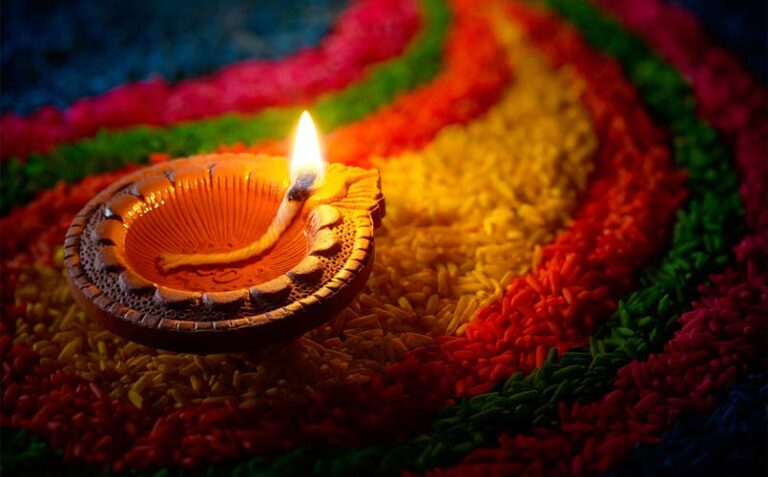We usher in the Indian New Year on 14th November as millions around the world celebrate the festival of lights Diwali, which is derived from the Sanskrit Deepavali meaning a line of lights.
Diwali symbolises the victory of good over evil, the triumph of light over darkness, and hope over despair. Families and friends gather in homes brightly lit with oil lamps and candles. Women dress in their finest, most colourful saris and decorate their doorway floors with bright powders in intricate Rangoli designs. Sweets and cakes are freely offered and gifts are exchanged amid joyous family reunions that culminate in firework displays.
In Hindu mythology, Diwali marks the return of the virtuous Lord Rama (representing God) and his idealised wife Sita (symbolising the mind) to their kingdom Ayodhya after spending 14 years in exile. Their story is told in the ancient Indian saga, the Ramayana – traditionally attributed to the Hindu sage Valmiki, and one of world literature’s biggest epics consisting of some 24,000 verses. The story narrates the life of Rama and his struggle to rescue his wife from the 10-headed demon king Ravana (representing the ego) who had kidnapped and absconded Sita to Lanka. With the help of his faithful friend, the monkey god Hanuman who symbolises prana, Rama rescues Sita after a terrible battle in which he shoots an arrow into Ravana’s one weak spot, killing him.
To celebrate the return of their king and queen, the residents of Ayodhya lit rows of clay lamps – to light the path on a dark, new moon night – as flowers and garlands rained from the heavens above.
Diwali has rich spiritual meaning – the rows of lights represent not just the essence of light in our lives but also gives us time to reflect on all that is good in life. The mythical stories told, all point to the importance of knowledge, self-inquiry and seeking the right path in life.
Each day of the four-day festival has a special thought or ideal attached to it. The first day is known Govatsa Dvadashi where the divine power in animals and nature is honoured. The second day is Dhanteras when wealth and prosperity are celebrated. The third day is known as Narak Chaturdashi – on this day it is said the goddess Kali and Lord Krishna destroyed the demon Narakasaru and freed the world from evil power. The fourth day is Deepavali – this year on 14th November – a time of conclusions and new beginnings filled with friendliness, generosity and goodwill when the goddess MahaLakshmi is celebrated.










